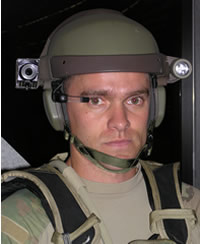The Future Force Warrior uniform suite will be fabricated from flexible structural framework designed for unconstrained vertical or lateral movement, even with full combat/assault load. For protection and enhanced survivability, standard uniforms will be replaced by a full spectrum protective combat ensemble, fabricated from ultra-lightweight materials which will also provide resistance to friction and wear, water, chemical and biological agents.
Protection elements
The suite will have a built-in microclimate conditioning system in garments made of spaced fabric, with built-in capillaries blowing hot or cold air through the system. Future combat clothing may also include embedded electrical conductors, for power distribution, communications and signature (heat) suppression. Additional layers of ballistic protective shield will provide sufficient multi-hit protection from small arms fire and shrapnel. The bulletproof shell will be separated from the body by foam pads absorbing impact trauma. This design provides additional protection to the rib cage, while maintaining air flow for body cooling. The protective vest will also be used as load-bearing chassis. New robotic platforms will be developed as part of the FFW program, to augment the team during dismounted operations. One vehicle will be the small individual soldier support system, a miniature robotic vehicle will help clear inside buildings; a squad level support vehicle assisting to transport loads and sustain the troops on dismounted missions; and a larger vehicle with both direct and indirect fire capabilities linking the FFW and FCS programs.
 Helmet & Headgear
Helmet & Headgear
The helmet will mount a new high definition see-through eyepiece, a GPS antenna, 3D audio and integrated bone conduction microphones (osteophone), which will replace the current headsets and enable efficient hands-free communications. Gel based sensors will also be integrated into the helmet, to monitor the human life signs (pulse and breathing rate). This information will become available for remote assisted medical support and real-time unit level status monitoring. The system will also support remote health monitoring and medical treatment. To assess the soldier’s physical condition and health status, the system will monitor the individual’s blood pressure, heart rate, internal and external body temperature, and caloric consumption rate. Commanders and medics will be able to access the information through a tactical local area network. Early warning of heat and cold injuries could be provided before serious effects develop. Such conditions are responsible for a large percentage of casualties in both battle and training. If a soldier is injured, medics can start making an assessment before they even get to an injured soldier. A specialist physician, who can be miles away, will now be able to diagnose and treat a soldier who is about to have sunstroke, without even physically seeing the soldier.
Additional parts of this article:
- Land Warrior & Stryker Warrior Programs
- Land Warrior System
- Land Warrior Infantry Combat Suite Stryker Vehicle Integration
- Future Force Warrior Infantry Combat Suite
- Future Force Warrior Uniform, Protection and Combat Gear
- Future Force Warrior Communication and Computation



















